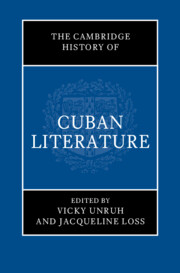Book contents
- The Cambridge History of Cuban Literature
- The Cambridge History of Cuban Literature
- Copyright page
- Dedication
- Contents
- Figures
- Contributors
- Acknowledgments
- Introduction Unfinished Histories
- Part I Literature in the Early Colony
- Part II Cuban Literature’s Long Nineteenth Century
- Part III Literary and Intellectual Culture in the Twentieth-Century Republic
- Part IV The Revolution’s Literary-Cultural Initiatives and Their Early Discontents
- Part V Cuba and Its Diasporas into the New Millennium
- 31 Alternative Cultural Projects and Their Histories
- 32 Ediciones Vigía and the Cultural Legacies of Matanzas
- 33 The Fiction of Cuba’s Special Period
- 34 Critique and Decentralization in Cuban Film After 1989
- 35 The Temporality of Twentieth- and Twenty-First-Century Cuban Theater
- 36 The Long Reach of Haiti in Cuban Literature
- 37 Cuban Afterlives of the Cuban and Angolan Revolutions
- 38 Anti-Exceptionalism in Detective Fiction, Speculative Fiction, and Graphic Novels
- 39 Cuban Women’s Writing at the Turn of the Millennium
- 40 Queering the Revolution and Its Diasporas
- 41 The Performance Art of Global Cuba
- 42 Twenty-First-Century Cuban Film and Diaspora
- 43 Cuba’s Poetic Imaginary (1989–2020)
- 44 Prose Narratives from Cuban America
- 45 Cuban Theater of the Diaspora in the United States
- Epilogue
- Select Bibliography
- Index
- References
33 - The Fiction of Cuba’s Special Period
from Part V - Cuba and Its Diasporas into the New Millennium
Published online by Cambridge University Press: 31 August 2024
- The Cambridge History of Cuban Literature
- The Cambridge History of Cuban Literature
- Copyright page
- Dedication
- Contents
- Figures
- Contributors
- Acknowledgments
- Introduction Unfinished Histories
- Part I Literature in the Early Colony
- Part II Cuban Literature’s Long Nineteenth Century
- Part III Literary and Intellectual Culture in the Twentieth-Century Republic
- Part IV The Revolution’s Literary-Cultural Initiatives and Their Early Discontents
- Part V Cuba and Its Diasporas into the New Millennium
- 31 Alternative Cultural Projects and Their Histories
- 32 Ediciones Vigía and the Cultural Legacies of Matanzas
- 33 The Fiction of Cuba’s Special Period
- 34 Critique and Decentralization in Cuban Film After 1989
- 35 The Temporality of Twentieth- and Twenty-First-Century Cuban Theater
- 36 The Long Reach of Haiti in Cuban Literature
- 37 Cuban Afterlives of the Cuban and Angolan Revolutions
- 38 Anti-Exceptionalism in Detective Fiction, Speculative Fiction, and Graphic Novels
- 39 Cuban Women’s Writing at the Turn of the Millennium
- 40 Queering the Revolution and Its Diasporas
- 41 The Performance Art of Global Cuba
- 42 Twenty-First-Century Cuban Film and Diaspora
- 43 Cuba’s Poetic Imaginary (1989–2020)
- 44 Prose Narratives from Cuban America
- 45 Cuban Theater of the Diaspora in the United States
- Epilogue
- Select Bibliography
- Index
- References
Summary
This chapter examines the abundance of Cuban fiction that emerged in the “Special Period in Times of Peace,” roughly between the period’s official designation in 1990 and the mid-2000s, as well as major scholarship on the period. Positing the “living ruin” as the period’s primary trope, the chapter sees in this fiction a persistent, unbridled human vitality against a backdrop of urban decay, disenchantment, and political anachronism, with dirty realist Pedro Juan Gutiérrez and Antonio José Ponte as bookends to the period’s spectrum of thematic and formal possibilities. Other fiction writers examined include, among others, José Miguel Sánchez (Yoss), Leonardo Padura Fuentes, Abilio Estévez, Ena Lucía Portela, Senel Paz, Jesús Díaz, Eliseo Alberto, Wendy Guerra, José Manuel Prieto, Anna Lidia Vega Serova, Adelaida Fernández de Juan, and Antonio Armenteros. Among the major transformations registered in this fiction are increased visibility of racial inequities, greater permissiveness toward homoeroticism, representations of tourism and sex as well as poverty, and a range of attitudes toward the Soviet period.
Keywords
- Type
- Chapter
- Information
- The Cambridge History of Cuban Literature , pp. 516 - 531Publisher: Cambridge University PressPrint publication year: 2024

